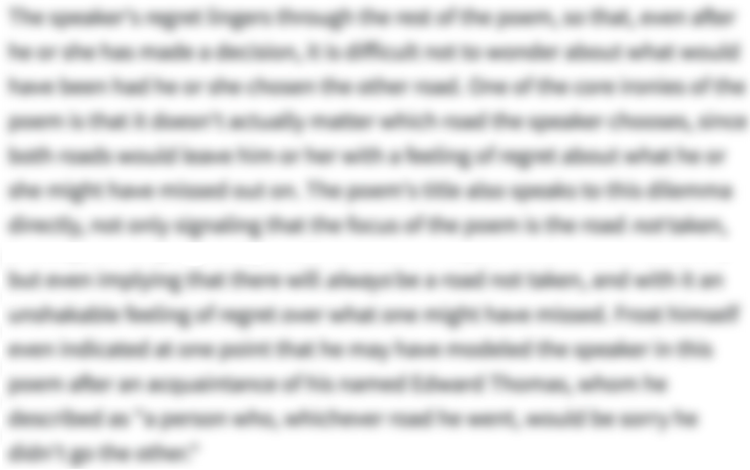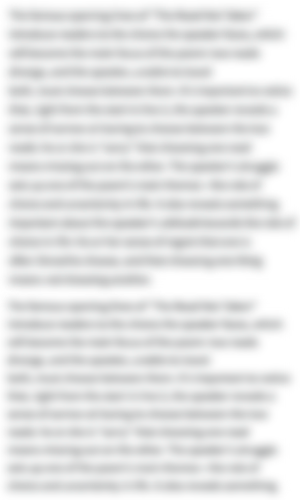-
“The Summer Day” Introduction
-
“The Summer Day” is a short poem by the American poet Mary Oliver, first published in her collection House of Light (1990). Its speaker wonders about the creation of the world and then has a close, marvelous encounter with a grasshopper. This prompts the speaker to meditate on mortality, human beings' relationship with nature, and the preciousness of life. One of Oliver's most famous poems, "The Summer Day" ultimately challenges readers to find and fulfill their life's purpose.
-
-
“The Summer Day” Summary
-
The speaker wonders about the world's creation, asking who made animals like the swan, black bear, and grasshopper. The speaker is talking about a specific grasshopper, actually—one who has just jumped from the grass in front of the speaker. The speaker feeds this grasshopper some sugar and watches as the insect chews, moving her jaws horizontally instead of vertically (as human beings do when they chew). The grasshopper looks around with her huge, complex eyes before wiping her face clean with her light-colored legs. Then she quickly spreads her wings and sails away in the air. The grasshopper gone, the speaker reflects on not knowing how to pray. What the speaker does know, however, is how to be attentive to the world, and how to sink down and kneel in the grass. The speaker does know how to rest and feel fortunate, and how to walk casually through the fields, which is exactly what the speaker has spent the day doing. Addressing the reader directly, the speaker asks how else they should have spent the day, given that life is short and everything dies too soon. The speaker then asks the reader how they themselves plan to spend the one glorious life they're going to get.
-
-
“The Summer Day” Themes
-

The Purpose of Life
The speaker of “The Summer Day” muses about the nature of prayer, mortality, and, above all, life’s purpose. The poem doesn’t try to define the meaning of life but rather pushes readers to think about what life means to them—to figure out their own life's purpose and then do their best to honor it. For this speaker, living authentically and intentionally is more important than adopting a specific way of life.
After encountering the grasshopper, the speaker makes a sudden admission: “I don’t know exactly what a prayer is.” But the speaker does know “how to pay attention” (to the grasshopper, for instance). And that’s not all: the poem lists other things the speaker definitely knows how to do, such as fall and kneel down in the grass, be “idle and blessed,” and stroll through fields.
All of these things, it becomes clear, give the speaker’s life meaning. Spending quiet time outdoors simply observing the environment is a kind of prayer for the speaker, in that such activities help the speaker find a sense of joy, gratitude, and fulfillment.
The speaker thus feels no guilt about spending “all day” in nature, relaxing, and being “idle.” On the contrary, the speaker confidently asks, “what else should I have done?”
Since everything dies “at last, and too soon,” the speaker reasons, people should do their best to live with intention and immerse themselves in what they love. For this speaker, that means being outdoors, observing nature, and relaxing among the grass and grasshoppers.
By asking how “you” plan to spend “your one wild and precious life,” the poem ultimately implies that it's up to individuals to fill their own lives with meaning. While that meaning may come from appreciating nature, as it does for the speaker, the poem leaves open many other possibilities. Above all, “The Summer Day” challenges people to live with passionate purpose—whatever that purpose may be.
Where this theme appears in the poem:- Lines 1-19
-

The Beauty and Mystery of the Natural World
“The Summer Day” celebrates the wondrous beauty of nature. As the speaker first considers the origins of the world and its creatures, and then tenderly observes a single grasshopper, the poem implies that nature is mysterious in a wonderful way: though human beings don’t or can’t entirely understand nature, simply exploring it can make people feel that they’re a small and valuable part of a vast, beautiful, interconnected world.
The poem begins with a big question that reflects the speaker's awe of nature: “Who made the world?” The “world” could mean the entire universe or the planet Earth; either way, the question indicates the speaker’s wonder at the immense, perhaps unknowable scope of nature.
Next, the speaker asks somewhat more down-to-earth questions: “Who made the swan, and the black bear? / Who made the grasshopper?” These questions are more specific, but they’re still big, challenging, and perhaps impossible to answer! The poem doesn’t seem too anxious to come up with definite answers, however. Rather, these open-ended questions express the sense of majesty and astonishment the speaker feels when experiencing nature in all its mystery.
Following these big questions, the poem celebrates the beauty of a particular creature in a particular moment. Whereas the speaker previously wondered about the origin of grasshoppers in general, now the poem considers a specific grasshopper—one that is actually “eating sugar” from the speaker’s hand.
In some ways, the grasshopper is like a person—she “washes her face,” as a person might after a messy meal, and her insect legs remind the speaker of “pale forearms.” Yet the grasshopper is also very different from the speaker. She moves her jaws “back and forth”—not “up and down,” as people do—and unlike human beings, she can fly.
This encounter with a tiny grasshopper makes the speaker feel connected with nature, despite not entirely understanding where it came from. For the speaker, the grasshopper is a kind of simple, everyday miracle and a point of close connection with a natural world that remains distinct, mysterious, and perhaps unknowable. Encountering that miracle on the “[s]ummer [d]ay” of the poem fills the speaker with deep spiritual contentment, as well as the conviction that experiencing nature in this way is a truly worthwhile pursuit.
Where this theme appears in the poem:- Lines 1-19
-
-
Line-by-Line Explanation & Analysis of “The Summer Day”
-
Lines 1-3
Who made the ...
... made the grasshopper?"The Summer Day" begins with a question that human beings have grappled with essentially forever: "Who made the world?" Whether the speaker means the whole universe or just Earth, that's a big question to ask! Rather than try to answer it, however, the speaker immediately asks two more questions. These are a little more specific than the first, but they're still unwieldy, difficult, and related to creation.
These three questions can be called rhetorical, since they aren't really looking for answers. It's not even clear whom the speaker is talking to; the questions could be addressed to nature, an unknown deity, the speaker's inner self, readers of the poem, or no one in particular!
These questions indicate the awe that the speaker feels when thinking about nature. For this speaker, the simple existence of the natural world and its many kinds of inhabitants (from the swan to the black bear to the grasshopper) is a miracle. The speaker appears to be a curious, attentive, imaginative person—one who is perhaps more interested in asking questions than insisting on firm answers.
These opening lines are written in free verse; in other words, they don't follow a regular meter or rhyme scheme. The rest of the poem will follow this pattern, too, using lines of various lengths and rhythms. The flexibility of the verse allows for a wide range of expression and gives the poem an intimate, conversational feeling.
The title indicates that the poem takes place on a summer day, perhaps in a place where there are swans and black bears (as readers will see, there are definitely grasshoppers!). Notice that there's a subtle difference between calling the poem "The Summer Day" and "A Summer Day." A summer day might seem unremarkable—merely one of many days in the season—but the summer day is something special.
This slight elevation raises the spiritual, philosophical, and personal stakes of the poem and gives it an almost allegorical quality. This is the day when a special thing happened (or else, every day is the day to start making the most of your "wild and precious life").
-
Lines 4-8
This grasshopper, I ...
... and complicated eyes.

Unlock all 384 words of this analysis of Lines 4-8 of “The Summer Day,” and get the Line-by-Line Analysis for every poem we cover.
Plus so much more...
Get LitCharts A+ -
Lines 9-10
Now she lifts ...
... and floats away. -
Lines 11-15
I don't know ...
... doing all day. -
Lines 16-17
Tell me, what ...
... and too soon?
-
-
“The Summer Day” Symbols
-

The Grasshopper
In "The Summer Day," the grasshopper is an actual insect that eats sugar out of the speaker's hand, moves her jaws "back and forth," looks around, rubs her face with her "pale forearms," and then flies away. Closely encountering this particular grasshopper on this particular summer day makes the speaker feel deeply, intimately connected with nature.
But the grasshopper also symbolizes the larger mystery and grandeur of the natural world. Even as this single insect—whom the speaker personifies and calls "she"—gives the speaker a moment of close connection, it reminds the speaker of all the world's other creatures (including swans, black bears, and other grasshoppers). In this way, the grasshopper stands in for the awe-inspiring scope of nature, which the speaker believes human beings can enjoy but never fully comprehend.
Where this symbol appears in the poem:- Lines 3-10: “Who made the grasshopper? / This grasshopper, I mean— / the one who has flung herself out of the grass, / the one who is eating sugar out of my hand, / who is moving her jaws back and forth instead of up and down— / who is gazing around with her enormous and complicated eyes. / Now she lifts her pale forearms and thoroughly washes her face. / Now she snaps her wings open, and floats away.”
-
-
“The Summer Day” Poetic Devices & Figurative Language
-
Assonance
At several moments in "The Summer Day," assonance adds emphasis, indicates subtle connections between words, and/or helps to form imperfect rhymes. Take, for example, the imperfect (internal) rhyme in line 5 between "one" and "flung," which depends on the repeated /uh/ sound and emphasizes the speaker's playful personification of the grasshopper. (The insect hasn't just hopped randomly; she's "flung herself" with human-like agency and intention.)
Likewise, in lines 7–10, shared vowel sounds link "down," "around," and "Now," as well as "face" and "away." These effects add to the musicality of the verse, enhancing the beauty of the speaker's moment of connection with the grasshopper.
Two more examples of assonance demonstrate its expressive range in the poem. In lines 11-12, as the speaker asserts her spirituality despite not knowing "exactly what a prayer is," the repeated /o/ sound of "don't know" contrasts (in both sound and meaning) with "do know." In line 17, the doubled /oo/ sound adds emphasis to the speaker's claim that all things must die eventually, and far "too soon." This emphasis, in turn, helps drive home the speaker's larger point: that people should live their brief lives with awareness and purpose, whatever that means for them.
Where assonance appears in the poem:- Line 5: “one,” “flung”
- Line 7: “down”
- Line 8: “around”
- Line 9: “Now,” “face”
- Line 10: “Now,” “away”
- Line 11: “don't know”
- Line 12: “know”
- Line 17: “too soon”
-
Sibilance


Unlock all 145 words of this analysis of Sibilance in “The Summer Day,” and get the poetic device analyses for every poem we cover.
Plus so much more...
Get LitCharts A+ -
Alliteration
-
Consonance
-
Rhetorical Question
-
Anaphora
-
Juxtaposition
-
Personification
-
-
“The Summer Day” Vocabulary
Select any word below to get its definition in the context of the poem. The words are listed in the order in which they appear in the poem.
- Complicated
- Blessed
- Idle
- Wild
- Precious
Complicated-
(Location in poem: Line 8: “her enormous and complicated eyes.”)
This word likely refers to the fact that grasshoppers have two compound eyes, each of which contains numerous tiny lenses.
-
Form, Meter, & Rhyme Scheme of “The Summer Day”
-
Form
"The Summer Day" doesn't follow a traditional form. Instead, it contains a single stanza composed of 19 free verse lines (lines that don't follow a particular meter or rhyme scheme). This flexible form helps the poem reflect the natural, spontaneous movement of the speaker's curious mind.
Though "The Summer Day" doesn't follow a strict form, its single stanza can still be divided into rough sections:
- In lines 1–3 ("Who made [...] grasshopper?"), the speaker asks three rhetorical questions that express a sense of wonder at the mysteries of nature.
- Lines 4–10 ("This grasshopper [...] floats away.") detail the speaker's close encounter with a grasshopper.
- In lines 11–15 ("I don't know [...] all day."), the speaker meditates on prayer, spirituality, and attentiveness to the surrounding world.
- Finally, lines 16–18 ("Tell me [...] precious life?") ask three more questions, now seemingly directed at readers themselves. These questions consider mortality and the meaning of life, challenging readers to create meaning in their own lives.
-
Meter
"The Summer Day" is written in free verse, meaning that it doesn't follow a regular meter or rhyme scheme. Free verse tends to be highly flexible, and many poets began to favor it starting in the 20th century. In "The Summer Day," the free verse lines give the poem a conversational, relaxed, intimate tone. The lines range in length from very short to quite long, and their varied rhythms allow for a wide range of expression.
Even if it doesn't follow a regular meter, a poem can use rhythm to communicate meaning. In "The Summer Day," for example, the rhythm of line 2 helps express the speaker's wonder and curiosity about the natural world:
Who made | the swan, | and the | black bear?
This line is made up of four metrical feet: a spondee (dum-dum), an iamb (da-dum), a pyrrhic (da-da), and another spondee (dum-dum). But remember, the poem doesn't follow a regular meter, so the important thing is the effect of specific rhythms in particular moments.
Here, the initial double stress on "Who made" emphasizes the mystery of the "maker" as the speaker marvels and ponders. Likewise, the quick-then-slow rhythm of "and the black bear" reflects the additional wonder the speaker feels when thinking about the bear. The rhythm of this line draws attention to the juxtaposition between swan and bear, two very different animals that highlight the amazing variety of nature's creatures.
Line 5 provides another example of meaningful rhythm:
the one | who has flung | herself out | of the grass,
This line contains an iamb (da-dum) followed by three anapests (da-da-dum). Anapests typically create a light skipping or leaping rhythm—which is appropriate here, since this line describes a grasshopper hopping into the speaker's hand! It's as if the line itself is leaping along with the grasshopper, demonstrating how even free verse can use metrical effects to enhance its meaning.
-
Rhyme Scheme
"The Summer Day" is written in free verse, so it doesn't follow a regular meter or rhyme scheme. Its verse is flexible and highly expressive. The poem's formal freedom reflects both the way the speaker feels in nature and the way people's lives (according to the speaker) are "wild," free, and open to possibility.
There are a few subtle rhymes in "The Summer Day," however. For example, in lines 6–8, an imperfect rhyme between "down" and "around" adds emphasis to the speaker's moment of connection with the grasshopper.
Later in the poem, rhyme emphasizes the speaker's belief in the importance of finding purpose in life. In lines 16–19, "done" shares a slant rhyme with "soon," which, in turn, chimes with "do." These shared sounds increase the emotional intensity of the poem's closing rhetorical questions, which challenge readers to fulfill their life's purpose.
-
-
“The Summer Day” Speaker
-
Though the speaker of "A Summer Day" is unidentified, it's clear that this person is someone who is curious, attentive, and very fond of nature. The speaker is happy to spend "all day" in nature, walking around, lying down, observing a grasshopper, and being "idle and blessed." Though seemingly aware that some people might see this as a waste of time, the speaker is living life with purpose, and is therefore spiritually content. In the poem's final lines, the speaker challenges readers to live their own lives with purpose, whatever that purpose may be.
It's possible that the speaker is Mary Oliver herself, though there's no clear evidence of this in the poem. Still, it's notable that Oliver drew from her own experience with nature when writing her poems.
During her difficult childhood outside Cleveland, Ohio, Oliver would retreat to the natural shelter of the woods, where she first began writing poetry. For much of her life, she lived in Provincetown, Massachusetts, where the natural beauty of Cape Cod provided clear inspiration for her poems.
Likewise, Oliver expressed strong spiritual beliefs while remaining skeptical of organized religion; she would have shared the speaker's conviction that being in nature is itself a kind of prayer. Though the speaker of "A Summer Day" can't specifically be identified as Oliver, there's little doubt that they have much in common.
-
-
“The Summer Day” Setting
-
The poem clearly takes place in nature—somewhere with grass, fields, and grasshoppers, and probably swans and black bears, too. This pastoral setting is idyllic; the speaker is carefree, relaxed, and happy, and nothing in the setting threatens or spoils that happiness.
It's useful to note that some of Mary Oliver's poems were inspired by specific places in nature, especially the Ohio woods of her childhood and the landscape around Provincetown, Massachusetts, where she lived for much of her life. Though "The Summer Day" isn't clearly drawn from Oliver's own life, it was likely influenced by the natural environments she knew and loved.
-
-
Literary and Historical Context of “The Summer Day”
Literary Context
"The Summer Day" is arguably the most famous poem written by Mary Oliver (1935-2019), one of the most popular American poets of recent decades. The poem first appeared in Oliver's 1990 collection House of Light.
A prolific writer, Oliver published many books in her lifetime, including a number of bestsellers, and won the Pulitzer Prize and the National Book Award, among various other honors. She had a wide influence on both literary and popular culture; her work earned admiration from both critics and ordinary people seeking inspiration, solace, and beautiful words to live by.
Much of Oliver's writing, including "The Summer Day," is rooted in a deep appreciation of the natural world. British Romantic poets such as William Wordsworth, John Keats, and Percy Bysshe Shelley served as models for her exploration of humankind's relationship to nature.
Oliver was strongly influenced by the ecstatic free verse style of Walt Whitman, as well as the Transcendentalism of Ralph Waldo Emerson, Nathaniel Hawthorne, and Henry David Thoreau. As a young woman, she was also influenced by the work of Edna St. Vincent Millay, whose home she briefly lived in and whose papers she helped organize following Millay's death. Rumi, the 13th-century Persian poet, informed Oliver's distinctive approach to spirituality and the natural world.
The questions considered by "The Summer Day"—people's relationship to nature, spirituality, mortality, life's purpose—are typical of Oliver's poetry. By probing the mysteries and pleasures of human life on earth, Oliver enriched the lives of her many readers and set an example that still inspires poets today.
Historical Context
Mary Oliver grew up in a suburb of Cleveland, Ohio, where she endured an abusive father and a difficult childhood. As a girl, she would take shelter in the woods near her home; there, she began to write poems. Nature would remain the central preoccupation and driving force of her poetry throughout her life.
As an adult, Oliver lived for many years in Provincetown, Massachusetts, with her partner, Molly Malone Cook. She was known to take long walks in the woods before sunrise with her dogs, and the natural surroundings of Cape Cod often influenced her poems, sometimes in specifically recognizable ways. Later in life, she lived in Florida, a very different natural environment that also shaped her work.
"The Summer Day" is not clearly influenced by any particular time or place in Oliver's life, and it's not certain that the speaker is Oliver herself. Nonetheless, Oliver's poetry was defined by the close relationship she cultivated with nature from girlhood onward—and "The Summer Day" is no exception.
-
More “The Summer Day” Resources
-
External Resources
-
The Poet Remembered — The poet Billy Collins reflects on Oliver's poetic legacy.
-
The Poem Out Loud — Listen to Mary Oliver read "The Summer Day."
-
Oliver's Life and Work — A brief biography of Oliver from the Poetry Foundation.
-
What Is Nature Poetry? — A short entry on nature poetry by the poet Edward Hirsch.
-
Listening to the World — A rare interview with Oliver from the On Being Project.
-
-
LitCharts on Other Poems by Mary Oliver
-








